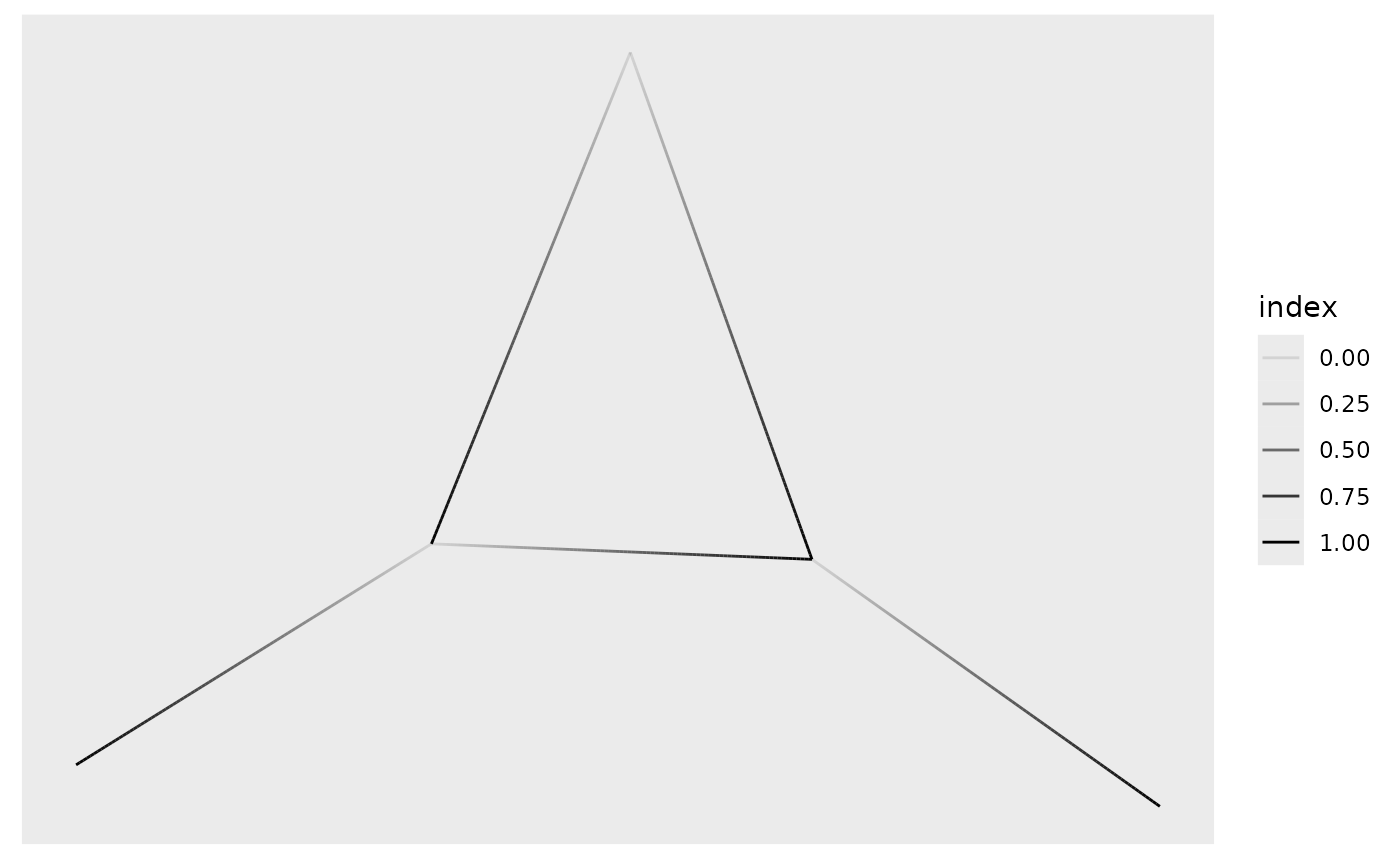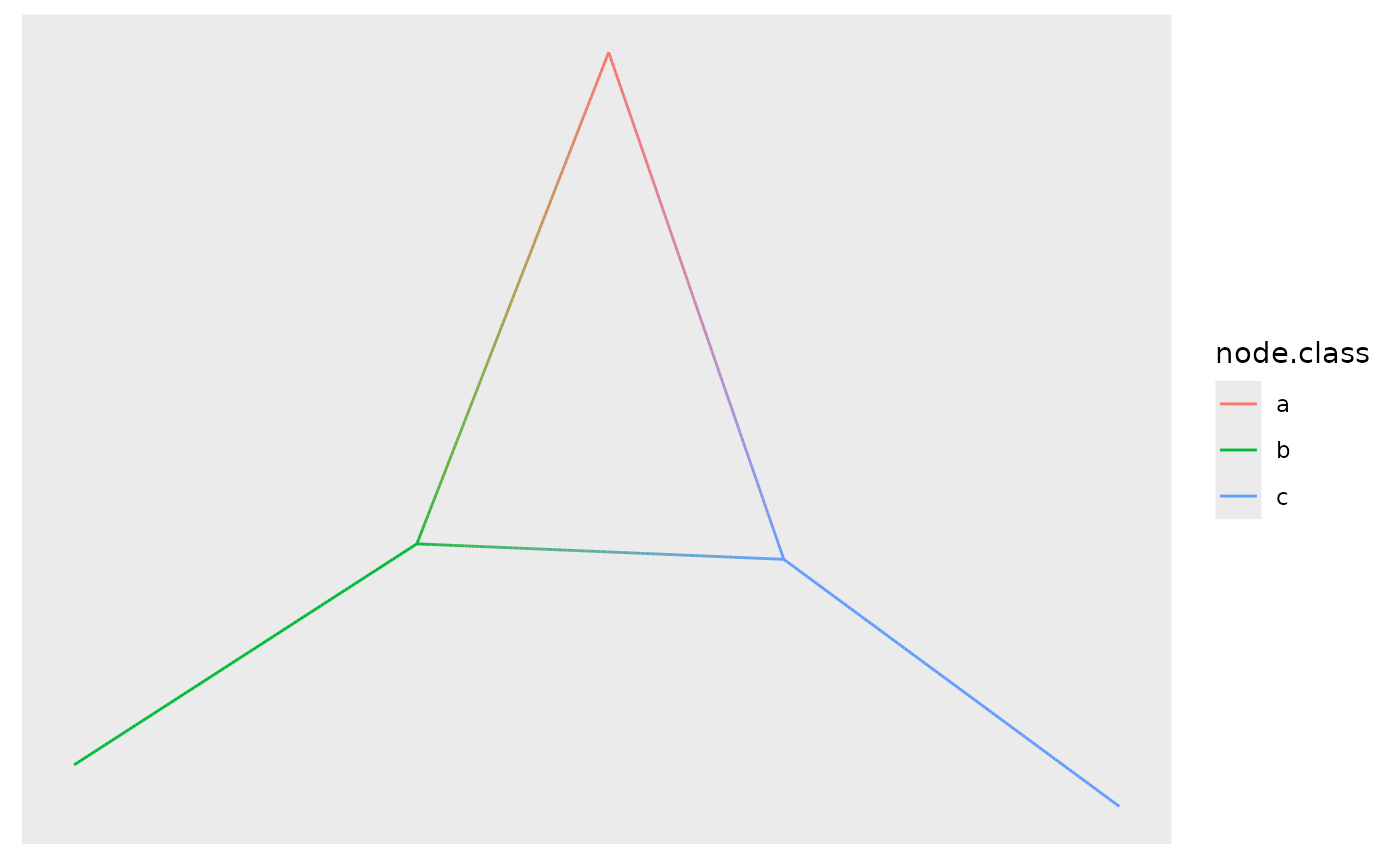This geom draws edges in the simplest way - as straight lines between the start and end nodes. Not much more to say about that...
geom_edge_link(
mapping = NULL,
data = get_edges("short"),
position = "identity",
arrow = NULL,
n = 100,
lineend = "butt",
linejoin = "round",
linemitre = 1,
label_colour = "black",
label_alpha = 1,
label_parse = FALSE,
check_overlap = FALSE,
angle_calc = "rot",
force_flip = TRUE,
label_dodge = NULL,
label_push = NULL,
show.legend = NA,
...
)
geom_edge_link2(
mapping = NULL,
data = get_edges("long"),
position = "identity",
arrow = NULL,
n = 100,
lineend = "butt",
linejoin = "round",
linemitre = 1,
label_colour = "black",
label_alpha = 1,
label_parse = FALSE,
check_overlap = FALSE,
angle_calc = "rot",
force_flip = TRUE,
label_dodge = NULL,
label_push = NULL,
show.legend = NA,
...
)
geom_edge_link0(
mapping = NULL,
data = get_edges(),
position = "identity",
arrow = NULL,
lineend = "butt",
show.legend = NA,
...
)Arguments
- mapping
Set of aesthetic mappings created by
ggplot2::aes()orggplot2::aes_(). By default x, y, xend, yend, group and circular are mapped to x, y, xend, yend, edge.id and circular in the edge data.- data
The return of a call to
get_edges()or a data.frame giving edges in correct format (see details for for guidance on the format). Seeget_edges()for more details on edge extraction.- position
A position adjustment to use on the data for this layer. This can be used in various ways, including to prevent overplotting and improving the display. The
positionargument accepts the following:The result of calling a position function, such as
position_jitter(). This method allows for passing extra arguments to the position.A string naming the position adjustment. To give the position as a string, strip the function name of the
position_prefix. For example, to useposition_jitter(), give the position as"jitter".For more information and other ways to specify the position, see the layer position documentation.
- arrow
Arrow specification, as created by
grid::arrow().- n
The number of points to create along the path.
- lineend
Line end style (round, butt, square).
- linejoin
Line join style (round, mitre, bevel).
- linemitre
Line mitre limit (number greater than 1).
- label_colour
The colour of the edge label. If
NAit will use the colour of the edge.- label_alpha
The opacity of the edge label. If
NAit will use the opacity of the edge.- label_parse
If
TRUE, the labels will be parsed into expressions and displayed as described ingrDevices::plotmath().- check_overlap
If
TRUE, text that overlaps previous text in the same layer will not be plotted.check_overlaphappens at draw time and in the order of the data. Therefore data should be arranged by the label column before callinggeom_text(). Note that this argument is not supported bygeom_label().- angle_calc
Either 'none', 'along', or 'across'. If 'none' the label will use the angle aesthetic of the geom. If 'along' The label will be written along the edge direction. If 'across' the label will be written across the edge direction.
- force_flip
Logical. If
angle_calcis either 'along' or 'across' should the label be flipped if it is on it's head. Default toTRUE.- label_dodge
A
grid::unit()giving a fixed vertical shift to add to the label in case ofangle_calcis either 'along' or 'across'- label_push
A
grid::unit()giving a fixed horizontal shift to add to the label in case ofangle_calcis either 'along' or 'across'- show.legend
logical. Should this layer be included in the legends?
NA, the default, includes if any aesthetics are mapped.FALSEnever includes, andTRUEalways includes. It can also be a named logical vector to finely select the aesthetics to display. To include legend keys for all levels, even when no data exists, useTRUE. IfNA, all levels are shown in legend, but unobserved levels are omitted.- ...
Other arguments passed on to
layer()'sparamsargument. These arguments broadly fall into one of 4 categories below. Notably, further arguments to thepositionargument, or aesthetics that are required can not be passed through.... Unknown arguments that are not part of the 4 categories below are ignored.Static aesthetics that are not mapped to a scale, but are at a fixed value and apply to the layer as a whole. For example,
colour = "red"orlinewidth = 3. The geom's documentation has an Aesthetics section that lists the available options. The 'required' aesthetics cannot be passed on to theparams. Please note that while passing unmapped aesthetics as vectors is technically possible, the order and required length is not guaranteed to be parallel to the input data.When constructing a layer using a
stat_*()function, the...argument can be used to pass on parameters to thegeompart of the layer. An example of this isstat_density(geom = "area", outline.type = "both"). The geom's documentation lists which parameters it can accept.Inversely, when constructing a layer using a
geom_*()function, the...argument can be used to pass on parameters to thestatpart of the layer. An example of this isgeom_area(stat = "density", adjust = 0.5). The stat's documentation lists which parameters it can accept.The
key_glyphargument oflayer()may also be passed on through.... This can be one of the functions described as key glyphs, to change the display of the layer in the legend.
Edge variants
Many geom_edge_* layers comes in 3 flavors depending on the level of control
needed over the drawing. The default (no numeric postfix) generate a number
of points (n) along the edge and draws it as a path. Each point along
the line has a numeric value associated with it giving the position along the
path, and it is therefore possible to show the direction of the edge by
mapping to this e.g. colour = after_stat(index). The version postfixed with a
"2" uses the "long" edge format (see get_edges()) and makes it
possible to interpolate node parameter between the start and end node along
the edge. It is considerable less performant so should only be used if this
is needed. The version postfixed with a "0" draws the edge in the most
performant way, often directly using an appropriate grob from the grid
package, but does not allow for gradients along the edge.
Often it is beneficial to stop the drawing of the edge before it reaches the
node, for instance in cases where an arrow should be drawn and the arrowhead
shouldn't lay on top or below the node point. geom_edge_* and geom_edge_*2
supports this through the start_cap and end_cap aesthetics that takes a
geometry() specification and dynamically caps the termini of the
edges based on the given specifications. This means that if
end_cap = circle(1, 'cm') the edges will end at a distance of 1cm even
during resizing of the plot window.
All geom_edge_* and geom_edge_*2 have the ability to draw a
label along the edge. The reason this is not a separate geom is that in order
for the label to know the location of the edge it needs to know the edge type
etc. Labels are drawn by providing a label aesthetic. The label_pos can be
used to specify where along the edge it should be drawn by supplying a number
between 0 and 1. The label_size aesthetic can be used to control the size of
the label. Often it is needed to have the label written along the direction
of the edge, but since the actual angle is dependent on the plot dimensions
this cannot be calculated beforehand. Using the angle_calc argument allows
you to specify whether to use the supplied angle aesthetic or whether to draw
the label along or across the edge.
Edge aesthetic name expansion
In order to avoid excessive typing edge aesthetic names are
automatically expanded. Because of this it is not necessary to write
edge_colour within the aes() call as colour will
automatically be renamed appropriately.
Aesthetics
geom_edge_link and geom_edge_link0 understand the following
aesthetics. Bold aesthetics are automatically set, but can be overwritten.
x
y
xend
yend
edge_colour
edge_width
edge_linetype
edge_alpha
filter
geom_edge_link2 understand the following aesthetics. Bold aesthetics are
automatically set, but can be overwritten.
x
y
group
edge_colour
edge_width
edge_linetype
edge_alpha
filter
geom_edge_link and geom_edge_link2 furthermore takes the following
aesthetics.
start_cap
end_cap
label
label_pos
label_size
angle
hjust
vjust
family
fontface
lineheight
Computed variables
- index
The position along the path (not computed for the *0 version)
See also
Other geom_edge_*:
geom_edge_arc(),
geom_edge_bend(),
geom_edge_bundle_force(),
geom_edge_bundle_minimal(),
geom_edge_bundle_path(),
geom_edge_density(),
geom_edge_diagonal(),
geom_edge_elbow(),
geom_edge_fan(),
geom_edge_hive(),
geom_edge_loop(),
geom_edge_parallel(),
geom_edge_point(),
geom_edge_sf(),
geom_edge_span(),
geom_edge_tile()
Examples
require(tidygraph)
gr <- create_notable('bull') %>%
mutate(class = sample(letters[1:3], n(), replace = TRUE)) %>%
activate(edges) %>%
mutate(class = sample(letters[1:3], n(), replace = TRUE))
ggraph(gr, 'stress') +
geom_edge_link(aes(alpha = after_stat(index)))
 ggraph(gr, 'stress') +
geom_edge_link2(aes(colour = node.class))
ggraph(gr, 'stress') +
geom_edge_link2(aes(colour = node.class))
 ggraph(gr, 'stress') +
geom_edge_link0(aes(colour = class))
ggraph(gr, 'stress') +
geom_edge_link0(aes(colour = class))
